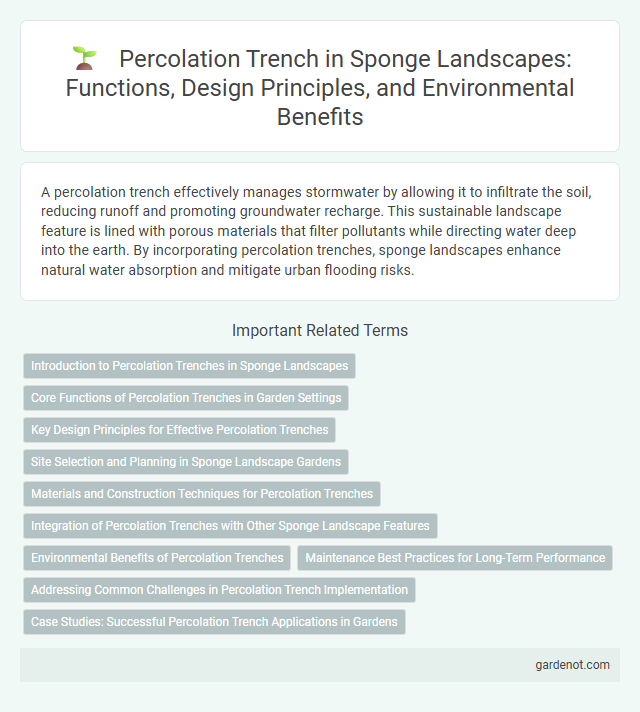A percolation trench effectively manages stormwater by allowing it to infiltrate the soil, reducing runoff and promoting groundwater recharge. This sustainable landscape feature is lined with porous materials that filter pollutants while directing water deep into the earth. By incorporating percolation trenches, sponge landscapes enhance natural water absorption and mitigate urban flooding risks.
Introduction to Percolation Trenches in Sponge Landscapes
Percolation trenches in sponge landscapes serve as engineered channels designed to capture and infiltrate stormwater runoff, promoting groundwater recharge and reducing surface flooding. These trenches are typically filled with porous materials such as gravel or coarse sand, which facilitate efficient water percolation while filtering pollutants. Incorporating percolation trenches enhances urban sustainability by mimicking natural hydrological processes and improving water management in developed areas.
Core Functions of Percolation Trenches in Garden Settings
Percolation trenches in garden settings primarily function to enhance stormwater infiltration, reducing surface runoff and preventing soil erosion. They improve groundwater recharge by allowing water to slowly percolate through permeable materials, thereby maintaining soil moisture levels essential for plant health. These trenches also filter pollutants and sediments, contributing to improved water quality within the garden ecosystem.
Key Design Principles for Effective Percolation Trenches
Effective percolation trenches require well-graded, permeable backfill materials such as crushed stone to maximize infiltration capacity while minimizing clogging risks. Proper trench dimensions, including trench width and depth, should be designed to match site-specific hydrological conditions and anticipated runoff volumes to ensure optimal water percolation rates. Incorporating a pre-treatment sedimentation basin upstream reduces sediment load, enhancing the trench's long-term functionality and durability in a sponge landscape system.
Site Selection and Planning in Sponge Landscape Gardens
Site selection for percolation trenches in sponge landscape gardens requires assessing soil permeability and topography to ensure efficient stormwater infiltration. Planning involves positioning trenches in low-lying areas or along contour lines to maximize water capture and prevent runoff. Incorporating native vegetation around the trenches enhances filtration and supports groundwater recharge within the sponge landscape system.
Materials and Construction Techniques for Percolation Trenches
Percolation trenches use coarse, clean aggregates such as crushed stone or gravel to facilitate efficient infiltration of stormwater into underlying soils. Geotextile fabrics are often placed around the trench to prevent soil migration while allowing water passage, enhancing longevity and performance. Construction involves excavating a shallow trench, lining it with geotextile, filling with selected aggregates, and sometimes integrating an underdrain system to manage overflow and maintain infiltration rates.
Integration of Percolation Trenches with Other Sponge Landscape Features
Percolation trenches integrate seamlessly with bioretention cells and rain gardens to enhance stormwater infiltration and reduce surface runoff. Combining these trenches with permeable pavements and green roofs optimizes groundwater recharge while minimizing urban flooding. Strategic placement within sponge landscapes maximizes the synergistic effects of multiple water retention and filtration systems.
Environmental Benefits of Percolation Trenches
Percolation trenches enhance groundwater recharge by facilitating the infiltration of stormwater into the soil, reducing surface runoff and mitigating flood risks. These trenches improve water quality by filtering pollutants and sediments before they enter aquifers, promoting healthier ecosystems. Implementing percolation trenches in sponge landscapes supports sustainable urban drainage, benefiting both the environment and local biodiversity.
Maintenance Best Practices for Long-Term Performance
Maintaining a percolation trench involves regular inspection to remove sediment buildup and prevent clogging, ensuring efficient groundwater infiltration. Periodic cleaning of inlet and outlet structures and surrounding vegetation control helps sustain optimal flow rates. Implementing a scheduled maintenance plan with monitoring after heavy rainfall supports long-term trench performance and longevity.
Addressing Common Challenges in Percolation Trench Implementation
Percolation trenches face common challenges such as soil clogging, poor infiltration rates, and sediment accumulation, which can reduce their effectiveness in managing stormwater runoff. Implementing proper pretreatment measures like sediment traps and routinely maintaining trenches helps mitigate clogging and preserves infiltration capacity. Selecting site-specific soil conditions with adequate permeability and considering trench dimensions tailored to runoff volume optimize performance and longevity.
Case Studies: Successful Percolation Trench Applications in Gardens
Percolation trenches in gardens have demonstrated effective stormwater management by enhancing infiltration and reducing surface runoff. Case studies reveal that integrating native plants and layered gravel media in these trenches significantly improves water quality and soil moisture retention. Successful applications include urban residential gardens where percolation trenches mitigate flooding while promoting healthy plant growth.
Percolation trench Infographic

 gardenot.com
gardenot.com